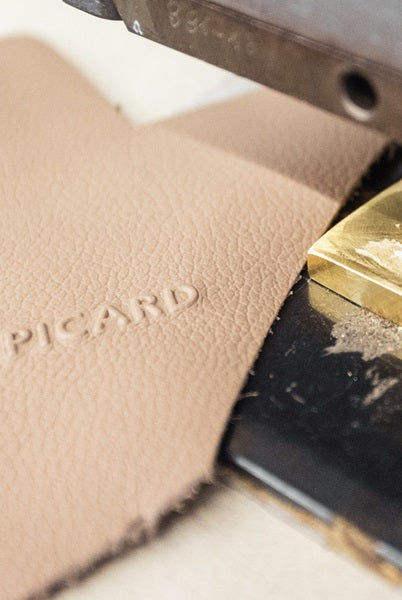Your leather jewel has been with you for a while now; it is a reliable companion on the way to work, when meeting friends and on your last city trip. You can clearly see the marks and you think that now is the time to do something good for your leather.
Perfect, because with this guide we want to give you tips on how to clean your faithful companion and freshen up the old leather.
Why does leather change?
As you know, leather is a natural product, it is an animal skin which is used in
- Clothing,
- accessories
- and furniture was manufactured.
It is exposed to the sun , occasionally even in the rain and of course we touch our leather again and again.
Dust and dirt can also age our leather if you don't care for it regularly. Light-colored leather can discolor if it comes into contact with your jeans.
These are all factors that contribute to leather changing. The leather can darken a little over time or look greasy. But seams and fasteners can also come loose through daily use .

Can I condition leather at home?
Yes, you definitely can. You probably already have suitable cleaners in your cupboard. We'll tell you which ones you can use to remove stains , clean the leather properly and then pamper it with the right care .
How to prepare leather
Step 1: Remove dust & dirt

Remove loose dust and dirt , preferably with a leather cleaning brush or a damp cloth .
Please use a cleaning brush that is specifically designed for your leather . You can remove dirt from seams using an old, damp toothbrush.
Step 2: Remove stains

Remove stains : Depending on the type of leather, you can use household remedies to remove stains . We'll tell you which ones in the text below. You can of course also use a professional care product, just make sure it's suitable for your type of leather and follow the instructions.
No matter which type of cleaning you choose, always test it first on an inconspicuous area.
Step 3: Remove scratches

After cleaning, you can remove small scratches with a special leather sanding pad and then treat them with a leather color spray . When buying, make sure that it is the same color as your leather and follow the application instructions.
You can repair small holes with leather glue; use a colorless leather glue if possible.
Step 4: Care for leather

As a final step, you can now care for and protect the leather by waterproofing it. To do this, use a waterproofing agent that is tailored to your leather.
Can brittle leather be reconditioned?
Yes and no! It is said that it is “already too late” for brittle leather, but depending on how badly the leather is damaged, it can still be treated and protected. Whether the leather can still be saved also depends on the
- Type,
- Quality,
- coloring
- and processing.
High-quality leather requires more time to recondition than low-quality leather. Leather that is not too badly damaged can be treated and cared for with a special leather grease/balm.
Expert tip: It is important to know that despite successful leather processing, cracks or brittle areas will still be visible. You can avoid brittle leather by regularly caring for and waterproofing the leather.
How can old leather be reconditioned?
An old piece of leather needs care and treatment . Leather is a very robust material , but it is also exposed to stress over time. For this reason, you should care for the leather regularly and store it properly when you are not using it.
The first step is to clean the leather. If the leather is old, you should be particularly careful and make sure you use the right cleaner for your leather. Suede needs to be cleaned differently than smooth leather.
Sometimes the leather can be “dry” or brittle, in this case you can use a leather balm after cleaning to revitalize it.
But please be careful , rough leathers such as suede should never be treated with leather balm or leather grease . Afterwards, impregnate your treated leather and store it in a cloth bag, lying down and not in a damp room or exposed to direct sunlight. Also avoid folding or bending your leather.
If your piece of leather needs to have seams, fasteners or even straps repaired, you can have this done by a specialist who can then carry out the repair directly.

What household remedies can you use to treat leather?
Old leather does not have to be taken to a specialist for restoration straight away. Depending on how much wear and tear your leather is under, you can clean and care for it yourself using these household remedies .
Please always do a small test run on an invisible area first and use a household remedy that is suitable for your leather. We will tell you what these are here.
Vinegar essence
Stains and dirt can be easily removed with a mixture of vinegar and water ; if possible, use distilled water to avoid limescale stains.
A cotton cloth and a mixture of vinegar and water should now tackle the stains. Simply add a few drops of vinegar essence to the water and treat the stain with the cloth.
Please dab your leather clean , do not rub too much on a stain as this could make it bigger or damage your leather surface. If you notice mold stains on your leather, you can also remove them very well with vinegar.
Vinegar kills the mold and cleans your leather. Before you clean the entire piece of leather, always test it on an inconspicuous area first.
Wet wipes
Yes, you read that correctly, you can also use baby wipes to remove stains from smooth leather . If the stains are older, you can try to gently tackle the stain with baby wipes. Baby wipes generally do not contain alcohol, so you should be able to remove grease stains or light dirt with them.
It is especially important that you do not rub the stain too hard and that you test the cleaning on a small, inconspicuous area first.
Curd soap
You can also use soap to clean smooth leather, but of course you should not simply rub it onto the leather.
- Dissolve a little bit of soap in lukewarm water,
- soak a clean cotton cloth in it,
- wring it out properly
- and start cleaning the stains and all the leather.
Please do not use microfiber cloths to clean smooth leather, as these can attack and degrease the surface.
However, you should not use this tip for rough, suede or aniline leather , as these leathers are open-pored and require a different type of cleaning. Fresh grease stains are removed better with curd soap than old grease stains, but that is the case with all types of stains.
Sandpaper
Oh yes, you read that right, even if it sounds strange, sandpaper is a great cleaner for suede . It is particularly suitable for large areas. Please never use sandpaper on smooth leather, as this could damage the surface.
To clean, moisten the surface of the leather and then rub it gently and carefully with the sandpaper. Do not rub too hard and go over the leather carefully so as not to damage it.
Eraser
You can also use an eraser to remove oil and grease stains from suede . There are special suede erasers, but the eraser from your pencil case will also do the job. It is important that you use a colorless eraser to avoid discoloration.
Maybe you have a magic sponge in your cupboard , you can use this in the same way as the eraser. You can use the eraser as you would on a piece of paper, but please do not rub too hard on the leather to avoid damaging it.
Baking powder and flour
No, we're not baking a cake together, we promise! You can use flour and baking powder to clean smooth and suede leather , especially fresh oil and grease stains.
- Sprinkle flour or baking powder on the fresh grease stain
- and give the powder time to absorb the fat.
- You can then tap off the powder or brush it off lightly.
- To brush, please use a brush that is suitable for your leather.
Coconut oil
You can use coconut oil to care for smooth leather ; it is a natural care product that you may already have in your cupboard. After cleaning, leather needs care, just like our skin.
Using a clean and dry cotton cloth, you can absorb some coconut oil and spread it on the leather in circular movements.
This will make your leather soft and supple and also protect it from dust and moisture. Please do not use coconut oil or other oils on suede as it would stick to the velvety surface and ruin the roughened effect.

After processing, the leather will appreciate a little care, which you can give it by rubbing it with a leather balm and waterproofing it.
Please always choose cleaning and care products specifically tailored to your leather and always test it on an inconspicuous area.
What do I need to pay attention to when preparing leather?
When reconditioning old leather, it is important to know what type of leather it is and how severe the signs of wear are.
If the signs of wear are not too severe, you can clean the leather yourself, either with household remedies or professional leather cleaners.
Cleaning is the most important part of the preparation process . After cleaning, you can then move on to preparation and care. This may involve repairing small scratches or caring for the leather with the appropriate care products.
If you notice that the signs of wear are more severe , fasteners and straps have been damaged, or there are large holes in the leather, you can also take the leather to a specialist for restoration. They will know what to do and will restore the old leather, so that your leather will continue to accompany you for many years to come.
How to recondition leather seats?
There are a few things you need to consider when reconditioning leather seats, chairs or an armchair . First of all, you need to be clear about how much damage or dirt is on your seat.
The greater the damage, the greater the effort required to repair it. Depending on the condition, it may not be possible to reuse the seats after they have been reconditioned.
New seats should be given a leather sealant to prevent abrasion and discoloration from heavy use.
You can restore the seats yourself , or you can decide to have the work done by professionals. If you decide to restore the leather yourself, you will need a few tools .
- Special grease,
- Cleaning supplies,
- cleaning petrol,
- Leather glue
- and possibly a sanding pad are required.
First of all, you have to prepare the leather treatment . The preparation includes cleaning the leather .
The leather may need to be removed from the seat , the leather should be greased and then treated with cleaning petrol .
It can then be repaired using leather glue and sanding pad. Finally, leather care is applied - after this, the seats will look like new again.
Conclusion
Restoring old leather is always worthwhile, whether you want to do it yourself or have it done by a professional.
Leather should be cleaned regularly and stored in a “species-appropriate” manner, but there is no way around reconditioning it.
That's why leather is such a popular material; it is robust and yet can be restored so that it can accompany you for many years.
FAQ
Where can I have leather reconditioned?
There are a number of specialist companies that specialize in cleaning leather sofas, car seats and other items. But you can also have your leather reconditioned at a saddlery or upholstery shop.
How much does it cost to have leather reconditioned?
You can't say that in general, because it also depends on the condition of the leather and of course on whether it is a leather handbag or a car seat that needs to be reconditioned. However, professional reconditioning also includes repairs to seams, holes, scratches and tears, so it's a complete package for the leather.
Can you clean leather with dishwashing detergent?
Yes, you can clean it with dishwashing liquid, but it should never be applied pure to the stain to be treated. A few drops of dishwashing liquid mixed with water are suitable for cleaning light and large-scale dirt. For suede types, we would recommend that you avoid cleaning with dishwashing liquid and use a professional suede cleaner.








